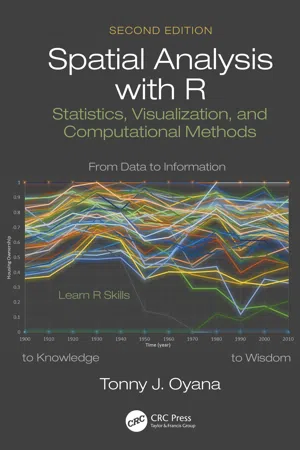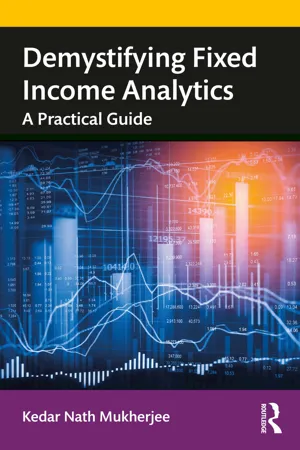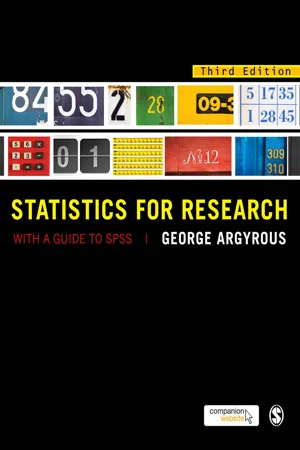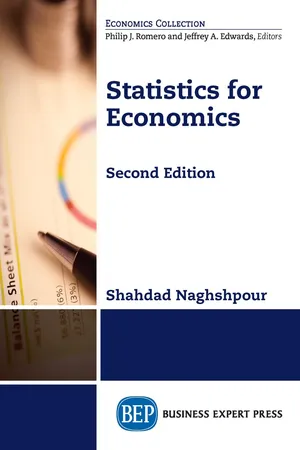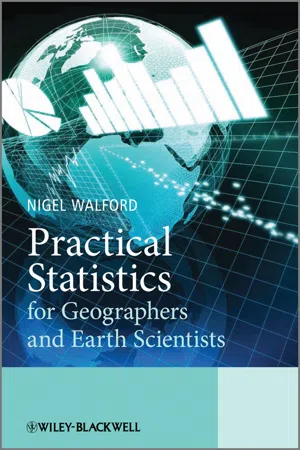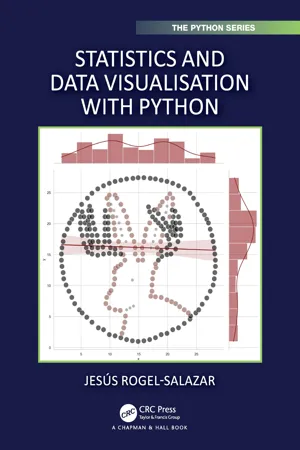Mathematics
Statistical Measures
Statistical measures are numerical values used to describe and summarize the features of a dataset. They include measures of central tendency (such as mean, median, and mode) and measures of dispersion (such as range, variance, and standard deviation). These measures provide insights into the distribution and characteristics of the data, aiding in the interpretation and analysis of statistical information.
Written by Perlego with AI-assistance
Related key terms
10 Key excerpts on "Statistical Measures"
- eBook - ePub
Spatial Analysis with R
Statistics, Visualization, and Computational Methods
- Tonny J. Oyana(Author)
- 2020(Publication Date)
- CRC Press(Publisher)
All statistical approaches noted earlier typically begin with a comprehensive evaluation of the spectrum of data values obtained for each of the variables included in a dataset. These assessments rely on the use of descriptive measures that are presented in a numerical, tabular, or graphical format. Regardless of the format used, descriptive measures are generated to provide a fundamental understanding of the distribution of observations in a dataset. Using tabular summaries (such as frequency tables), graphical summaries (such as bar charts, line graphs, boxplots, stem and leaf, Normal QQ plots), and statistical summaries (mean, median, standard deviation), these statistics help us organize our data. They may also offer suggestive clues about the patterns and trends present in the data, and possibly help generate new research hypotheses.Descriptive statistics differ from inferential statistics in the sense that the latter are used in the estimation of population parameters and the testing of hypotheses using information drawn from sample data. Descriptive statistics often provide the preliminary information about the sample characteristics, which could then be used for undertaking inferential statistics so that a specific hypothesis can be confirmed or rejected. Both approaches support efforts through which inferences about a population can be made that could be helpful in quantifying statistical relationships, making generalizations and statistical predictions. Two of the most commonly used sets of descriptive measures are the measures of center and the measures of dispersion. These measures are described along with their geographic counterparts in spatial analysis.Measures of Central TendencyMode refers to the value that occurs most frequently in a specific set of ungrouped observations. For example, inTable 3.1 - Glenn Hymel(Author)
- 2005(Publication Date)
- Mosby(Publisher)
Our earlier clarifications regarding differenceoriented, association-oriented, and descriptiveoriented research strategies are relevant as illustrations at this point. If our research question is descriptive oriented in nature, then presumably we are using a descriptive-oriented research method to investigate it. In so doing, we would invoke one or more appropriate descriptive statistical techniques to analyze the study’s resulting data. And within the context of the descriptive statistics available, the measurement scale used would also help to inform our decision as to which statistical technique is most appropriate.This theme of three determinants of statistical technique selection will become even more apparent as we continue our conceptual coverage into the subdivisions of both descriptive and inferential statistics that follows.DESCRIPTIVE STATISTICS
Expanding on our characterization of descriptive statistics, this family of statistical techniques includes the following categories: graphical techniques, measures of central tendency, measures of variability , and measures of correlation when hypothesis testing is not the intent.The graphical techniques include among the most common such displays as histograms, bar graphs, pie charts, and stem and leaf plots. The measures of central tendency identify values relative to a data set that are, in a sense, most representative of the “tending” or “tendency” of the group of scores as a whole. Included here are the mean, median, and mode. The mean is simply the arithmetic average; the median is the midpoint above and below which 50% of the scores fall; and the mode is the most frequently appearing score in the data set. Regarding the measures of variability , each of these is a value that represents from a given perspective the extent of “spread,” “variation,” or “diversification” in a set of scores. The most commonly recognized measures of variability are the range, variance, and standard deviation. The range is the distance between the highest and lowest scores in a data set whereas the variance might be thought of as somewhat of an “average” extent to which the individual scores vary or deviate from the mean. The standard deviation, in turn, is simply the square root of the variance. Regarding measures of correlation- William P. Fox, Rodney X. Sturdivant(Authors)
- 2022(Publication Date)
- Chapman and Hall/CRC(Publisher)
3Statistical MeasuresDOI: 10.1201/9781003317906-3Objectives
- Learn how to use R to obtain and interpret descriptive statistics for the center (location), spread, and shape of the distribution of a data set.
- Learn how to use R to obtain displays and be able to interpret them.
- Know what the measures are and which ones are used for quantitative data and which ones are better for qualitative data.
3.1 Measures of Central Tendency or Location
3.1.1 Describing the Data
In addition to plots and tables, numerical descriptors are often used to summarize data. Three numerical descriptors, the mean, the median, and the mode, offer different ways to describe and compare data sets. These are generally known as the measures of location.3.1.2 The Mean
The mean is the arithmetic average, with which you are probably very familiar. For example, your academic average in a course is generally the arithmetic average of your graded work. The mean of a data set is found by summing all the data and dividing this sum by the number of data elements.The following data represent 10 scores earned by a student in a college mathematics course: 55, 75, 92, 83, 99, 62, 77, 89, 91, 72. We find the mean in the same way you would compute the student’s average. The mean can be found by summing. We first sum the 10 scores:55 + 75 + 92 + 83 + 99 + 62 + 77 + 89 + 91 + 72 = 795and then divide by the number of data elements (10), 795/10 = 79.5.To describe this process in general, we can represent each data element by a letter with a numerical subscript. Thus, for a class of n tests, the scores can be represented by a1 , a2 , …, an . The mean of these n values of a1 , a2 , …, an is found by adding these values and then dividing this sum by n- eBook - ePub
Demystifying Fixed Income Analytics
A Practical Guide
- Kedar Nath Mukherjee(Author)
- 2020(Publication Date)
- Routledge India(Publisher)
3 Basic statisticsKey learning outcomesAt the end of this chapter, the readers are expected to be familiar with:- Descriptive Statistical Measures required to analyze financial market data
- Correlation and regression analysis required to understand and analyze the interrelationship between various segments of financial markets and between financial products.
- Theory of probability and some important probability distributions that some financial data are expected to follow to understand and analyze the statistical behavior of financial products using their historical observations.
- Testing the statistical significance of necessary statistical estimates required to analyze the financial market data.
Measures of central tendencyA large volume of data in itself is of very little use in arriving at any meaningful conclusions. Therefore, it becomes necessary to obtain a single number to represent a whole mass of data. This single figure would describe an entire series of observations of varying sizes. Such a typical value usually occupies a central position, so that some observations are larger and some smaller than it. There are various measures to convert a huge mass of data into a single representative figure, commonly known as Measures of Central Tendency and include mean, median, and mode.Arithmetic mean/averageArithmetic mean is considered to be the easiest and simplest measure of central tendency that fulfills all the criteria of a satisfactory average measure. This measure is based on all observations and is also easy to calculate. As far as sample fluctuations are concerned, arithmetic mean has been found to be the most stable measure of central tendency. In other words, if many samples are drawn from the same statistical population, arithmetic mean will be found to fluctuate less than any other measures of central tendency.The arithmetic mean of a set of observations is defined as their sum, divided by the number of observations. If X1 , X2 , . . ., Xn are the values of a variable with frequencies f1 , f2 ,. . .. . .., fn - eBook - ePub
Statistics for Research
With a Guide to SPSS
- George Argyrous(Author)
- 2011(Publication Date)
- SAGE Publications Ltd(Publisher)
PART 3Descriptive statistics: Numerical measures
Passage contains an image
NINEMeasures of central tendency
Learning objectives
At the end of this chapter you will be able to:- identify the main measures of central tendency
- calculate the mean, median, and mode for a given set of data
- understand the limitations of each measure of central tendency
- use SPSS to generate measures of central tendency for univariate, bivariate, and multivariate analysis
Part 2 looked at the description of data in graphical and tabular form. Tables and graphs as a form of describing data give some sense of the overall distribution of cases. For example, a quick glance at a frequency table or a histogram will identify the value that seems to be the ‘centre’ of the distribution. However, we sometimes want to capture this feature of the data in more precise terms: what does the ‘typical’ or ‘average’ case look like?Measures of central tendency
Measures of central tendency(also known as measures of location) are univariate descriptive statistics.Measures of Central TendencyMeasures of central tendencyindicate the typical or average value for a distribution.There are three common measures of central tendency: the mode, median, and mean. Each measure embodies a different notion of average and, as Table 9.1 indicates, choosing which to calculate on a given set of data is restricted by the level at which a variable is measured.Table 9.1 Measures of central tendencyMeasure Data considerations Mode Can be used with all levels of measurement, but not useful with scales that have many values Median Can be used with ranked data (ordinal and interval/ratio), but not useful for scales with few values Mean Can be used for interval/ratio data that are not skewed In this table we can see one of the basic rules of statistics: techniques that can be applied to a particular level of measurement can also be applied to a higher level. For example, the measure of central tendency that can be calculated for nominal data (mode) can also be calculated for ordinal and interval/ratio data. This should be borne in mind as you read the rest of the book; when I refer to nominal-level statistical techniques I really mean ‘nominal or above’, and ordinal data techniques really refers to ‘ordinal or above’. The converse, however, is not true: measures that can be calculated for a particular level of measurement cannot always be calculated for lower levels - eBook - ePub
- Shahdad Naghshpour(Author)
- 2015(Publication Date)
- Business Expert Press(Publisher)
CHAPTER 2Numerical Descriptive Statistics for Quantitative VariablesIntroductionOne of the purposes of descriptive statistics is to summarize the information in the data for a variable into as few parameters as possible. Measures of central tendency provide concise summaries of a population. They are also called measures of location as in Table 1.1 in Chapter 1 . Measures of central tendency are addressed first. However, they are often not enough to provide the full picture of reality, as will be demonstrated when the concept of variance is introduced shortly. The addition of measures of dispersion, such as the variance, provides a more complete picture of reality. Measures of dispersion are followed by measures of association.Measures of Central TendencyThis section discusses statistics that represent information about the nucleus of data.MeanThe arithmetic mean, or simply the mean, is the most commonly used descriptive measure. Other names for the mean are the average, mathematical expectation, and the expected value. This section deals with raw or ungrouped data.Arithmetic MeanThe arithmetic mean is the representative or typical value that represents a population. The mean is the sum of all the elements in the population divided by the number of the elements.The symbol μ, pronounced mu, is used to represent the population mean. The symbol Σ, called capital sigma, represents the sum of the values for a variable. The subscript “i” represents observations 1 through N. When there is no ambiguity, the index and subscripts are not included:The population mean is a parameter and provides information about the central tendency of the data. The mean is susceptible to extreme values. Since all values of the population are used in calculation of the mean, a single very large or very small value can have a major impact on the mean. This is not quite as important in the case of a population as it is with samples. - Nigel Walford(Author)
- 2011(Publication Date)
- Wiley(Publisher)
4 Statistical Measures (or quantities)4.1 Descriptive statisticsLearning outcomes This chapter will enable readers to:Chapter 4 concentrates on the basic descriptive measures or quantities that can be derived to compare and contrast sets of numbers in their role as measuring quantifiable differences between attributes and variables. Attention is directed towards summary measures referring to numbers, such as the median, mean, range, and standard deviation, and to the location of geographical phenomena, such as mean centre and standard distance. This chapter establishes the characteristics of the basic measures and quantities that may be subject to statistical testing.- explain the purpose of spatial and nonspatial descriptive statistics for comparing and contrasting numerical data;
- identify the appropriate summary measures to use with variables recorded on different measurement scales;
- start to plan how to use descriptive statistics in an independent research investigation in Geography, Earth Science and related disciplines.
Descriptive statistics are one of two main groups of statistical techniques, the other is known as inferential statistics or hypothesis testing. Descriptive statistics are about obtaining a numerical measure (or quantity), or a frequency count to describe the characteristics of attributes and variables of observations in a dataset. We will look at frequency distributions, the principles of hypothesis testing and inferential statistics in Chapter 5, but for the present the latter can be defined as a group of analytical techniques that are used to find out if the descriptive statistics for the variables and attributes in a dataset can be considered as important or significant. Descriptive statistics are useful in their own right and in most geographical investigations they provide an initial entry point for exploring the complex mass of numbers and text that makes up a dataset. Some research questions can satisfactorily be answered using descriptive statistics on their own. However, in many cases this proves insufficient because of an unfortunate little problem known as sampling error,- eBook - ePub
- Jesus Rogel-Salazar(Author)
- 2023(Publication Date)
- Chapman and Hall/CRC(Publisher)
4 The Measure of All Things – StatisticsDOI: 10.1201/9781003160359-4We mentioned in Chapter 1that statistics is the art of learning from data. Statistics enables the creation of new knowledge and a good statistical foundation will help us understand a problem better and lead us to sound conclusions.Statistics is the art of learning from data.In that sense, statistics is not about simply looking at numbers, but about understanding data. In other words, statistics is all about numbers in context. We may take a look at a list of numbers and be able to calculate things like the mean or the standard deviation, but the context around the numbers enables us to make interpretations about the results we are seeing. Statistics lets us measure all sorts of things and make sense of information around us and not be overwhelmed or overloaded by it.It is all about numbers in context to enable understanding.In order to do this we need to be methodical in the way we acquire, organise and analyse available data. Given a particular phenomenon of interest, we know that the measurements we may record about it are varied. After all, if all measurements were exactly identical we would live in a very boring universe. Think of the students whose grades we encountered in Section 3.1.4 , wouldn’t it be strange if all af the grades were exactly the same for all students in all subjects?A universe not worth exploring for strange new worlds or seek out new life and new civilisations.Being methodical about our analysis is supported by having some definitions under our belt. We call a population the entire collection of things or subjects about which information is obtained for our analysis. A sample is a subset of the population, selected for study. Descriptive statistics help us describe data from our population, and we can use tables and graphs, as well as numerical aggregations to help us with our description. The data about our population may consist of a single or multiple characteristics, features or variables. In the case of a single variable, we are talking about a univariate dataset, and a multivariate - eBook - ePub
- Perry R. Hinton(Author)
- 2014(Publication Date)
- Routledge(Publisher)
Descriptive statistics2MEASURES OF ‘CENTRAL TENDENCY’ MEASURES OF ‘SPREAD’ DESCRIBING A SET OF DATA: IN CONCLUSION COMPARING TWO SETS OF DATA WITH DESCRIPTIVE STATISTICS SOME IMPORTANT INFORMATION ABOUT NUMBERS CHAPTER RECAPA major reason for calculating statistics is to describe and summarise a set of data. A mass of numbers is not usually very informative so we need to find ways of abstracting the key information that allows us to present the data in a clear and comprehensible form. In this chapter we shall be looking at an example of a collection of data and considering the best way of describing and summarising it.One hundred students sit an examination. After the examination the papers are marked and given a score out of one hundred. You are given the results and asked to present them to a committee that monitors examination performance. You are faced with the following marks:Fortunately, you are told the sort of questions the committee might ask:■ Can you describe the results of the examination?■ Can you give us a brief summary of them?■ What is the average mark?■ What is the spread of scores?■ What is the highest and lowest mark?■ Here are last year’s results, how do this year’s compare?You sit looking at the above table. The answers to the questions are not obvious from the ‘raw’ data, that is, the original data before any statistics have been calculated. We need to do something to make it clearer. The first thing that we can do is to list the data in order, from lowest to highest:With this ordering certain things are more apparent: we can now see the lowest and highest scores more easily, with the scores falling between 6 and 90.Another thing we can do to improve our presentation is to add up the number of people who achieved the same mark. We work out thefrequency - eBook - ePub
Understanding and Doing Successful Research
Data Collection and Analysis for the Social Sciences
- Shaun Best(Author)
- 2014(Publication Date)
- Routledge(Publisher)
11 Measurement and statistical inference By the end of this chapter you should have an understanding of:• the nature of measurement in social science research• relevant terms such as tabulation and array• how to read and construct a univariate frequency distribution and a grouped frequency distribution to present your own data• how to identify the central tendency by use of the median, mode and arithmetic mean• the meaning and significance of variance and standard deviation• index measurement, representational measurement and composite measurement• the well-established critiques of measurement in the social sciences• the link between a variable and an indicator• the four most commonly used scales of measurement: nominal, ordinal, interval and ratio• the meaning of inference in social science research• how to use the Statistical Package for the Social Scientist (SPSS).IntroductionMeasurement in the social sciences is a procedure whereby information is gathered from a number of indicators in the form of a single score. A common aspect of measurement in the social sciences is tabulation: this simply means to count the number of people or observations in a given group on the basis of a characteristic that you are interested in. Look at the array of data below that shows the ages of first-year students when they started their degree course. What does it show?21, 20, 17, 30, 51, 18, 19, 18, 18, 18, 20, 22, 19, 19, 22, 23, 37, 19, 19, 23, 18, 21, 22, 23, 18, 18, 20, 22, 18, 18, 18, 19, 19, 18, 18, 22, 19, 19, 18, 18, 18, 19, 21, 21, 23, 24, 24, 24, 25Most ages of undergraduates entering university seems to be around 18–19 years.The simplest method of constructing an analysis is a univariate frequency distribution: this simply means that the different ages in the array of data are listed, together with their frequency
Index pages curate the most relevant extracts from our library of academic textbooks. They’ve been created using an in-house natural language model (NLM), each adding context and meaning to key research topics.
